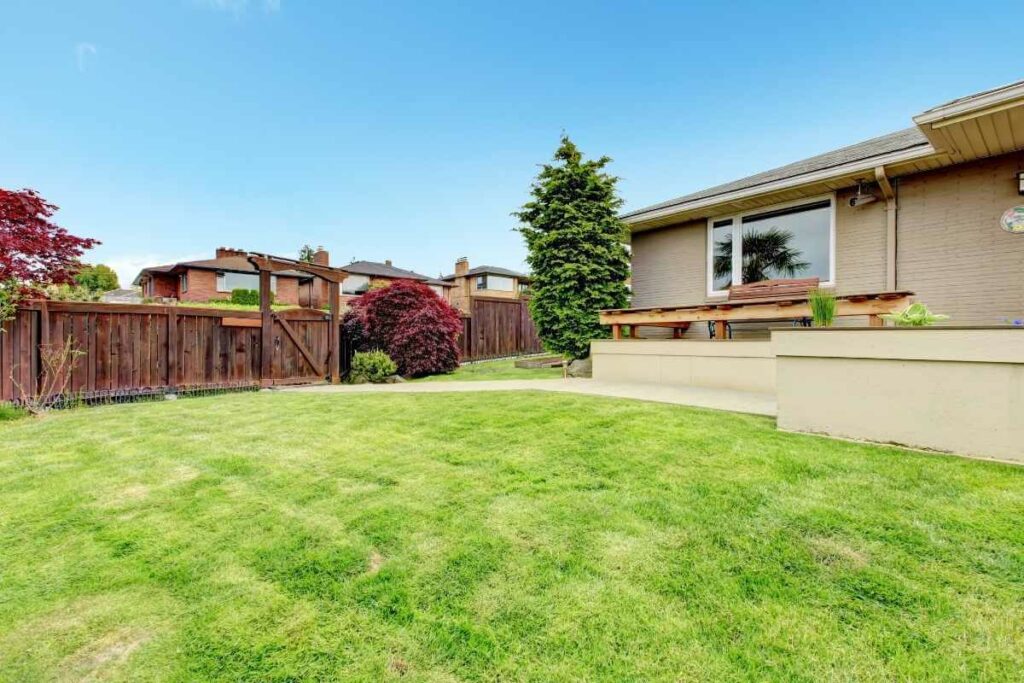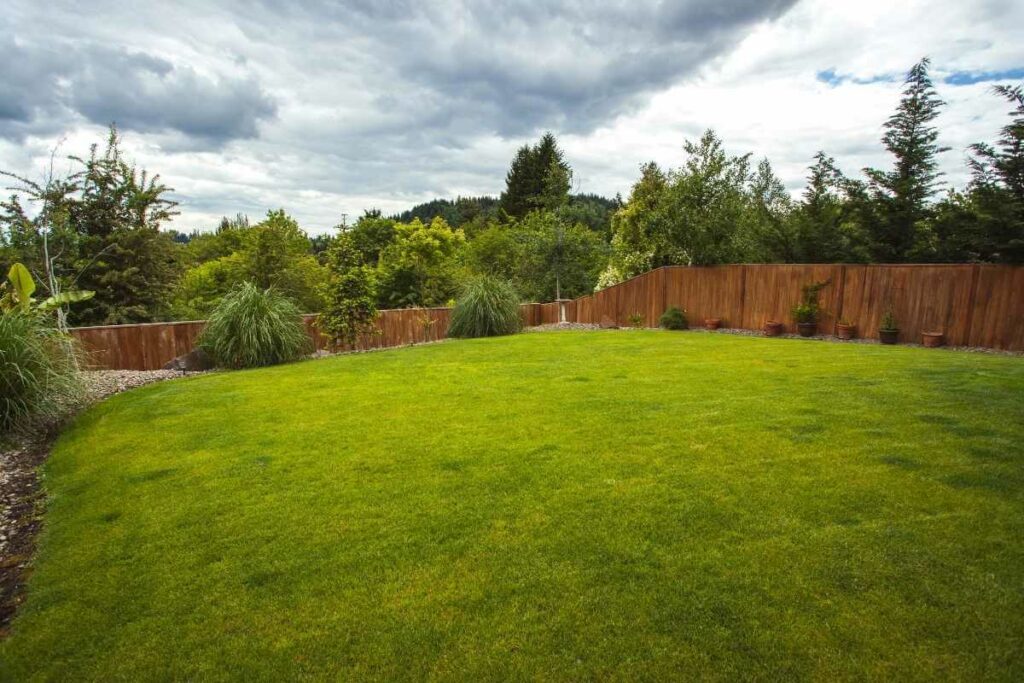One of the reasons that centipede grass is so popular, particularly in the southern United States is because of its resistance to tough conditions.
This type of turn can put up with much higher temperatures and requires very little maintenance.
What’s more, you won’t need to water your grass very often since centipede grass really only needs heavy watering during very dry weather.
That said, every type of grass has its problems and if you’ve noticed the health of your centipede grass is dwindling, then it might be caused by something you haven’t yet thought about.
In this guide, we will be looking at seven of the most common centipede grass problems and telling you what you can do about them.
It is important to keep in mind that, while centipede grass is hardy in zones 7 to 9, tackling problems as soon as you notice them will lower the risk of the grass dying off altogether.
7. Dollar Spot
Dollar spot may appear as small discolored circles across the surface of the lawn.

Many people confuse this with brown patch, which we will discuss later, but it is important to keep in mind that this isn’t the same thing:
- Unlike brown patch, the spots caused by dollar spot are much smaller and may be anywhere between two and four inches in diameter.
- You’ll typically find that dollar spot occurs on lawns where there is a lot of thatch or on lawns that are deprived of nitrogen.
- This centipede grass problem normally presents during the summer months. The good news is that it is relatively easy to treat and can be done by applying additional nitrogen to the lawn. You’ll need between one and three pounds for every 1000ft² of grass.
In addition to this, it is essential to mow your lawn to the correct height and be sure to water it well during those hot summer months to avoid dehydration.
Aerating the lawn is essential as this will improve both the airflow and drainage.
6. Brown Patch
As we have mentioned, brown patch and dollar spot can often be confused but the key difference is that brown patch affects a much larger area of lawn at once.
This is a fungal disease that is more common in wet weather or in the days and weeks thereafter. The lawn will turn yellow in patches and the size of these patches can range from just a few inches to a few feet.
If left untreated, the patches will then begin to dry out and the lawn will become much more sparse.
The bad news with brown patch is that, even after treatment, there is a good chance that the disease will still spread to other parts of the lawn.

For this reason, we would advise taking preventative measures as opposed to waiting for brown patch to show up and then trying to treat it.
There are plenty of fungicides out there that work well in the prevention of this disease but ensuring that you are careful with fertilizer is also essential (more on than later.)
In the same way that mowing at the correct height can help to prevent dollar spot, it can be just as effective at stopping the spread of brown patch.
Even Better: You’ll also want to make sure that any infected grass clippings are removed from the lawn and never used as mulch.
5. Problems With Nutrition
A lot of people are under the impression that centipede grass is so tough that they don’t need to worry about nutrients.
The problem is that, while this is a hardy species, it is very prone to fall victim to nutritional changes.
The effects of this can be devastating and the grass may develop any of the conditions that we have already discussed.
Some of the most common problems here are too high levels of nitrogen and phosphorus.
While grass does need these, there can be too much of a good thing:
- Potassium and iron levels should also be monitored to ensure that they do not fall too low and you should ensure that the pH level of the grass remains not too high or low. If these levels are not kept consistent then color and health changes are sure to follow.
- Centipede grass does far better in acidic soil and a pH level of 5.5 is ideal.
If you do notice that the grass is beginning to turn yellow, the chances are that it is to do with an iron deficiency in which case, you will need to apply ferrous sulfate to the lawn.
This should be mixed with 3 to 5 gallons of water for every 1000ft of grass.
4. Over Fertilizing
We know that it can be tempting to heavily fertilize your grass because you think you’re doing it a favor but this might not be the case.
It’s more about when you apply the fertilizer as putting on too much earlier on in the season can have the opposite effect than what you intended and may cause centipede grass decline.
The best time to apply fertilizer is during the early summer months and you’re better off using a fertilizer that doesn’t contain phosphorus.
Applying too much phosphorus can affect the health of the grass and it will also reduce the level of iron, which the grass needs to thrive. Once again, you’ll notice your grass turning yellow when this happens.
We have already talked about the fact that nitrogen in large quantities can affect the health of centipede grass so using fertilizers that contain a lot of this is a no-no.
Take a Closer Look: You’ll notice that the grass loses its beautiful apple green color and becomes much darker, often growing much more quickly too.
3. Fairy Rings
Fairy ring is a disease that causes dark yellow circles to appear on the lawn.
These areas are dead patches that can start off small, around three feet and spread to up to 20 feet in diameter!
If it is wet, you will notice that mushrooms begin to form around the perimeter of the rings which explains the cutesy name for the disease.
Sadly, there is currently no viable treatment for fairy rings so you’ll be left having to remove the dead grass and replace it with fresh turf.
But be sure to dig down to at least two or three inches into the soil to remove any remnants of the disease. The last thing you want is reinfection once you have laid your new turf.
2. Thatch
Thatch is something that affects a lot of different grasses and centipede grass is no exception.

This is a build-up of things like dead grass blades and roots, among other things.
The problem with thatch is that it can cause the already shallow roots of the centipede grass to take an even shallower root which will, in turn, make the grass more prone to the effects of temperature and drought.
Usually, thatch will appear over the winter when the grass is dormant although a lot of people believe that it is caused by using too much fertilizer; this is not the case.
The only way to treat your grass for thatch is to remove it which can be done with:
- a rake
- or a dethatcher
If the thatch is left in place, it will stop water and essential nutrients from penetrating down into the grassroots and provide a very welcoming environment for other nasties like bacteria and fungus.
It can sometimes be difficult to tell if there is thatch on a lawn as, on the surface, it may look perfectly healthy.
The best way to check is to test the sponginess of the lawn, too spongy and there’s a good chance there’s thatch underneath.
1. Effects Of The Weather
We have already mentioned several times that centipede grass is very hardy but there is only so much that it can take.
While it can handle hot weather very well, it doesn’t do so well when it is exposed to drought so you should ensure that you give it at least an inch of water every week in dry weather, if not an inch and a quarter.
If you fail to water it properly:
- Then the grass will begin to dry out and become very crispy.
- You’ll notice this when walking on it and the grass will likely sustain damage.
- If it is still left unwatered then it will eventually turn brown and dry out entirely.
- If centipede grass does not have full sun then it will not thrive as well as it could.
Generally speaking, this type of grass needs at least six hours of direct sunlight every day and without this, the grass is easily stressed.

When this happens, the lawn may become more sparse and you will begin to notice some bald spots.
The problem here is that these patches then become susceptible to weed growth.
Conclusion
Centipede grass may be one of the more hardy grasses, hence its popularity in zones 7 to 9.
However, that doesn’t make it indestructible and you must ensure you take good care of your lawn in order to prevent diseases and stress.
Also, you may need to use a pre-emergent to take care of weeds in your centipede grass.
Also Useful
- How to Stop Birds Eating Newly Sown Grass Seeds
- What Are Coated Grass Seeds? (Will Birds Eat Them?)
- Do Grass Seeds Die in the Cold?


